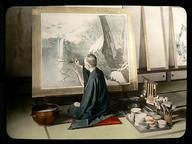Quiz Answer Key and Fun Facts
1. Which of these creatures is a symbol of fidelity in Chinese art?
2. A 'dagoba' most resembles which of these other architectural objects in Asia?
3. Qin Shi Huang Di, the Chinese emperor that united the country in 221 BC, established the 'small seal' script as the official writing style of the Chinese court. Prior to this, on most Chinese art and metalwork could be found 'great seal' characters. What is the term for 'great seal'?
4. This creature can be found in traditional art representing the Chinese emperor. To which mythical creature do you imagine I am referring?
5. Which of these is not an Asian 'dyeing' technique?
6. This is the Japanese name for the cosmic Buddha Vairocana, usually depicted in deep meditation seated on a lotus leaf.
7. In Chinese architecture, this is a complex system of wooden U-shaped locks that help support a roof.
8. Which of these words refers to 'celestial beings' that can be viewed in Hindu art?
9. The 'Dong Son' is an ancient bronze-age culture of which modern Asian country?
10. A 'dalang wayang' is a person who performs what function in Indonesian performance art?
Source: Author
thejazzkickazz
This quiz was reviewed by our editing team before going online.
Any errors found in FunTrivia content are routinely corrected through our feedback system.
